A Study to Assess the Conservation Effectiveness of Nature Reserves in Hainan, China, from 2000 to 2021
Abstract
1. Introduction
2. Study Area and Dataset
2.1. Study Area
2.2. Dataset
2.3. Methods
2.3.1. Habitat Quality Assessment
Habitat Quality Index
Habitat Degradation Index
2.3.2. Human Activity Disturbance
2.3.3. Conservation Effectiveness Evaluation
Determination of Index Weight
Evaluation Model Establishment
3. Results
3.1. Habitat Quality Assessment
3.1.1. Habitat Quality Index Change Status Analysis
3.1.2. Habitat Degradation Index Change Status Analysis
3.2. Human Activity Disturbance
3.3. Comprehensive Evaluation of the Effectiveness of Nature Reserve Protection
4. Discussion
5. Conclusions
Author Contributions
Funding
Acknowledgments
Conflicts of Interest
References
- Nelson, A.; Chomitz, K.M. Effectiveness of Strict vs Multiple Use Nature reserve in Reducing Tropical Forest Fires: A Global Analysis Using Matching Methods. PLoS ONE 2011, 6, e22722. [Google Scholar] [CrossRef]
- Hockings, M. Evaluting Nature Reserve Management—A Review of System for Assessing Management Effectiveness of Nature Reserve; University of Queensland: Lawes, Australia, 2000. [Google Scholar]
- Geldmann, J.; Barnes, M.; Coad, L.; Craigie, I.D.; Hockings, M.; Neil, D. Burgess. Effectiveness of terrestrial nature reserve in reducing habitat loss and population declines. Biol. Conserv. 2013, 161, 230–238. [Google Scholar] [CrossRef]
- Chen, Y.; Zhang, J.; Jiang, J.; Nielsen, S.E.; He, F. Assessing the effectiveness of China’s nature reserve to conserve current and future amphibian diversity. Divers. Distrib. 2017, 23, 146–157. [Google Scholar] [CrossRef]
- Armsworth, P.R.; Jackson, H.B.; Cho, S.-H.; Clark, M.; Fargione, J.E.; Iacona, G.D.; Kim, T.; Larson, E.R.; Minney e, T.; Sutton, N.A. Is conservation right to go big Nature reserve size and conservation return-on-investment. Biol. Conserv. 2018, 225, 229–236. [Google Scholar] [CrossRef]
- Watson, J.E.M.; Dudley, N.; Segan, D.B.; Hockings, M. The performance and potential of nature reserve. Nature 2014, 515, 67. [Google Scholar] [CrossRef] [PubMed]
- Bertzky, B.; Corrigan, C.; Kemsey, J. Protected Planet Report 2010: Tracking Progress towards Global Targets for Nature Reserve; IUCN: Gland, Switzerland; UNEP-WCMC: Cambridge, UK, 2012. [Google Scholar]
- Zupan, M.; Bulleri, F.; Evans, J.; Fraschetti, S.; Guidetti, P.; Garcia-Rubies, A.; Sostres, M.; Asnaghi, V.; Caro, A.; Deudero, S.; et al. How good is your marine nature reserve at curbing threats. Biol. Conserv. 2018, 221, 237–245. [Google Scholar] [CrossRef]
- Rodriguez-Galiano, V.F.; Ghimire, B.; Rogan, J.; Chica-Olmo, M.; Rigol-Sanchez, J.P. An assessment of the effectiveness of a random forest classifier for land-cover classification. Isprs J. Photogramm. Remote Sens. 2012, 67, 93–104. [Google Scholar] [CrossRef]
- Laurance, W.F.; Camargo, J.L.C.; Luizão, R.C.C.; Laurance, S.G.; Pimm, S.L.; Bruna, E.M.; Stouffer, P.C.; Williamson, G.B.; Benítez-Malvido, J.; Vasconcelos, H.L. The fate of Amazonian forest fragments: A 32-year investigation. Biol. Conserv. 2011, 144, 56–67. [Google Scholar] [CrossRef]
- Geldmann, J.; Manica, A.; Burgess, N.D.; Balmford, A. A global analysis of nature reserve management effectiveness. Environ. Manag. 2010, 46, 685–698. [Google Scholar]
- Gray, C.L.; Hill, S.L.L.; Newbold, T.; Hudson, L.N.; Börger, L.; Contu, S.; Hoskins, A.J.; Ferrier, S.; Purvis, A.; Scharlemann, J.P.W. Local biodiversity is higher inside than outside terrestrial nature reserve worldwide. Nat. Commun. 2016, 7, 12306. [Google Scholar] [CrossRef]
- Fuller, R.A.; McDonald-Madden, E.; Wilson, K.A.; Carwardine, J.; Grantham, H.S.; Watson, J.E.M.; Klein, C.J.; Green, D.C.; Possingham, H.P. Replacing underperforming nature reserve achieves better conservation outcomes. Nature 2010, 466, 365. [Google Scholar] [CrossRef] [PubMed]
- Nagendra, H.; Lucas, R.; Honrado, J.P.; Jongman, R.H.; Tarantino, C.; Adamo, M.; Mairota, P. Remote sensing for conservation monitoring: Assessing nature reserve, habitat extent, habitat condition, species diversity, and threats. Ecol. Indic. 2013, 33, 45–59. [Google Scholar] [CrossRef]
- Blom, A.; Yamindou, J.; Prins, H.H.T. Status of the nature reserve of the Central African Republic. Biol. Conserv. 2004, 118, 479–487. [Google Scholar] [CrossRef]
- Ellis, E.C.; Ramankutty, N. Putting people in the map: Anthropogenic biomes of the world. Front. Ecol. Environ. 2008, 6, 439–447. [Google Scholar] [CrossRef]
- Erle, C.; Kees, E.; Goldewijk, K.; Siebert, S.; Lightman, D.; Ramankutty, N. Anthropogenic transformation of the biomes, 1700 to 2000. Glob. Ecol. Biogeogr. 2010, 19, 589–606. [Google Scholar]
- Smith, E.R. An Overview of EPA’s Regional Vulnerability Assessment (ReVA) Program. Environ. Monit. Assess. 2000, 64, 9–15. [Google Scholar] [CrossRef]
- Nelson, E.; Mendoza, G.; Regetz, J.; Polasky, S.; Tallis, H.; Cameron, D.; Chan, K.M.; Daily, G.C.; Goldstein, J.; Kareiva, P.M.; et al. Modeling Multiple Ecosystem Services, Biodiversity Conservation, Commodity Production, and Tradeoffs at Landscape Scales. Front. Ecol. Environ. 2009, 7, 4–11. [Google Scholar] [CrossRef]
- Chen, L.-C.; Papandreou, G.; Kokkinos, I.; Murphy, K.; Yuille, A.L. Deeplab: Semantic Image Segmentation with Deep Convolutional Nets, Atrous Convolution, and Fully Connected Crfs. IEEE Trans. Pattern Anal. Mach. Intell. 2017, 40, 834–848. [Google Scholar] [CrossRef]
- Zhang, Z.; Xia, F.; Yang, D.; Huo, J.; Wang, G.; Chen, H. Spatiotemporal characteristics in ecosystem service value and its interaction with human activities in Xinjiang, China. Ecol. Indic. 2020, 110, 105826. [Google Scholar] [CrossRef]
- Balme, G.A.; Slotow, R.; Hunter, L.T.B. Edge effects and the impact of nonprotected areas in carnivore conservation: Leopards in the Phinda-MkhuzeComplex, South Africa. Anim. Conserv. 2010 13, 315–323.
- Bertzky, B.; Corrigan, C.; Kemsey, J.; Kenney, S.; Ravilious, C.; Besancon, C.; Burgess, N.D. Protected Planet Report: Tracking Progress towards Global Targets for Protected Areas; IUCN and UNEP-WCMC: Gland, Switzerland; Cambridge, UK, 2012. [Google Scholar]
- Hilborn, R.; Arcese, P.; Borner, M.; Hando, J.; Hopcraft, G.; Loibooki, M.; Mduma, S.; Sinclair, A.R.E. Effective enforcement in a conservation area. Science 2006, 314, 1266. [Google Scholar] [CrossRef]
- Chape, S.; Harrison, J.; Spalding, M.; Lysenko, I. Measuring the extent and eddectiveness of nature reserve as an indicator for meeting global biodiversity targets. Philos. Trans. R. Soc. Lond. 2005, 360, 443–455. [Google Scholar] [CrossRef] [PubMed]
- Hockings, M.; Stolton, S.; Leverington, F.; Dudley, N.; Courrau, J. Evaluating Effectiveness: A Framework for Assessing Management Effectiveness of Protected Areas, 2nd ed.; IUCN: Gland, Switzerland; Cambridge, UK, 2006; p. xiv + 105. [Google Scholar]
- Soutullo, A. Extent of the global network of terrestrial nature reserve. Conserv. Biol. 2010, 24, 362–363. [Google Scholar]
- Berger, A.R.; Hodge, R.A. Natural Change in the Environment: A Challenge to the Pressure-State-Response Concept. Soc. Indic. Res. 1998, 44, 255–265. [Google Scholar] [CrossRef]
- Sánchez-Canales, M.; Benito, A.L.; Passuello, A.; Terrado, M.; Ziv, G.; Acuña, V.; Schuhmacher, M.; Elorza, F.J. Sensitivity analysis of ecosystem service valuation in a Mediterranean watershed. Sci. Total Environ. 2012, 440, 140–153. [Google Scholar] [CrossRef] [PubMed]
- Leh, M.D.K.; Matlock, M.D.; Cummings, E.C.; Nalley, L.L. Quantifying and mapping multiple ecosystem services change in West Africa. Agric. Ecosyst. Environ. 2013, 165, 6–18. [Google Scholar] [CrossRef]
- Jin, S.; Sader, S.A. MODIS time-series imagery for forest disturbance detection and quantification of patch size effects. Remote Sens. Environ. 2005, 99, 462–470. [Google Scholar] [CrossRef]
- Pouliot, D.; Latifovic, R.; Fernandes, R.; Olthof, I. Evaluation of annual forest disturbance monitoring using a static decision tree approach and 250 m MODIS data. Remote Sens. Environ. 2009, 113, 1749–1759. [Google Scholar] [CrossRef]
- DeVries, B.; Verbesselt, J.; Kooistra, L.; Herold, M. Robust monitoring of small-scale forest disturbances in a tropical montane forest using Landsat time series. Remote Sens. Environ. 2015, 161, 107–121. [Google Scholar] [CrossRef]
- Huang, C.; Goward, S.N.; Masek, J.G.; Thomas, N.; Zhu, Z.; Vogelmann, J.E. An automated approach for reconstructing recent forest disturbance history using dense Landsat time series stacks. Remote Sens. Environ. 2010, 114, 183–198. [Google Scholar] [CrossRef]
- Huang, C.; Goward, S.N.; Schleeweis, K.; Thomas, N.; Masek, J.G.; Zhu, Z. Dynamics of national forests assessed using the Landsat record: Case studies in eastern United States. Remote Sens. Environ. 2009, 113, 1430–1442. [Google Scholar] [CrossRef]
- Blake, S.; Deem, S.L.; Strindberg, S.; Maisels, F.; Momont, L.; Isia, I.-B.; Douglas-Hamilton, I.; Karesh, W.B.; Kock, M.D. Roadless wilderness area determines forest Elephant movements in the Congo Basin. PLoS ONE 2008, 3, e3546. [Google Scholar] [CrossRef] [PubMed]
- Verbesselt, J.; Zeileis, A.; Herold, M. Near real-time disturbance detection using satellite image time series. Remote Sens. Environ. 2012, 123, 98–108. [Google Scholar] [CrossRef]
- Kennedy, R.E.; Yang, Z.; Gorelick, N.; Braaten, J.; Cavalcante, L.; Cohen, W.B.; Healey, S. Implementation of the LandTrendr Algorithm on Google Earth Engine. Remote Sens. 2018, 10, 691. [Google Scholar] [CrossRef]
- Andam, K.S.; Ferraro, P.J.; Hanauer, M.M. The effects of nature reserve systems on ecosystem restoration: A quasi-experimental design to estimate the impact of Costa Rica’s nature reserve system on forest regrowth. Conserv. Lett. 2013, 6, 317–323. [Google Scholar]
- Kennedy, R.E.; Yang, Z.; Cohen, W.B. Detecting trends in forest disturbance and recovery using yearly Landsat time series: 1. LandTrendr—Temporal segmentation algorithms. Remote Sens. Environ. 2010, 114, 2911–2924. [Google Scholar] [CrossRef]
- Kennedy, R.E.; Cohen, W.B.; Schroeder, T.A. Trajectory-based change detection for automated characterization of forest disturbance dynamics. Remote Sens. Environ. 2007, 110, 370–386. [Google Scholar] [CrossRef]
- Running, S.W.; Nemani, R.R.; Heinsch, F.A.; Zhao, M.; Reeves, M.; Hashimoto, H. A continuous satellite-derived measure of global terrestrial primary production. BioScience 2004, 54, 547−560. [Google Scholar] [CrossRef]
- Masek, J.G.; Huang, C.; Wolfe, R.; Cohen, W.B.; Kutler, J.; Hall, F.G.; Nelson, P. North American forest disturbance mapped from a decadal Landsat record: Methodology and initial results. Remote Sens. Environ. 2008, 112, 2914–2926. [Google Scholar] [CrossRef]
- Cohen, W.B.; Yang, Z.; Healey, S.P.; Kennedy, R.E.; Gorelick, N. A LandTrendr multispectral ensemble for forest disturbance detection. Remote Sens. Environ. 2018, 205, 131–140. [Google Scholar] [CrossRef]
- Zhu, Z.; Woodcock, C.E. Object-based cloud and cloud shadow detection in Landsat imagery. Remote Sens. Environ. 2012, 118, 83–94. [Google Scholar] [CrossRef]
- Bartz, K.K.; Ford, M.J.; Beechie, T.J.; Fresh, K.L.; Pess, G.R.; Kennedy, R.E.; Rowse, M.L.; Sheer, M. Trends in Developed Land Cover Adjacent to Habitat for Threatened Salmon in Puget Sound, Washington, USA. PLoS ONE 2015, 10, e0124415. [Google Scholar] [CrossRef] [PubMed]
- Zhu, Z. Change detection using Landsat time series: A review of frequencies, preprocessing, algorithms, and applications. ISPRS J. Photogramm. Remote Sens. 2017, 130, 370–384. [Google Scholar] [CrossRef]
- Griffiths, P.; Kuemmerle, T.; Kennedy, R.E.; Abrudan, I.V.; Knorn, J.; Hostert, P. Using annual time-series of Landsat images to assess the effects of forest restitution in post-socialist Romania. Remote Sens. Environ. 2012, 118, 199–214. [Google Scholar] [CrossRef]
- Schneibel, A.; Stellmes, M.; Röder, A.; Frantz, D.; Kowalski, B.; Haß, E.; Hill, J. Assessment of spatio-temporal changes of smallholder cultivation patterns in the Angolan Miombo belt using segmentation of Landsat time series. Remote Sens. Environ. 2017, 195, 118–129. [Google Scholar] [CrossRef]
- Healey, S.P.; Cohen, W.B.; Yang, Z.; Brewer, C.K.; Brooks, E.B.; Gorelick, N.; Hernandez, A.J.; Huang, C.; Hughes, M.J.; Kennedy, R.E.; et al. Mapping forest change using stacked generalization: An ensemble approach. Remote Sens. Environ. 2018, 204, 717–728. [Google Scholar] [CrossRef]
- Homer, C.; Dewitz, J.; Fry, J.; Coan, M.; Hossain, N.; Larson, C.; Herold, N.; McKerrow, A.; VanDriel, J.N.; Wickham, J. Completion of the 2001 National Land Cover Database for the conterminous United States. Photogramm. Eng. Remote Sens. 2007, 73, 337–341. [Google Scholar]
- Macedo, D.R.; Hughes, R.M.; Ferreira, W.R.; Firmiano, K.R.; Silva, D.R.; Ligeiro, R.; Kaufmann, P.R.; Callisto, M. Development of a benthic macroinvertebrate multimetric index (MMI) for Neotropical Savanna headwater streams. Ecol. Indic. 2016, 64, 132–141. [Google Scholar] [CrossRef]
- Mazari-Hiriart, M.; PMazari-Hiriart, M.; P´erez-Ortiz, G.; Orta-Ledesma, M.T.; Armas-Vargas, F.; Tapia, M.A. Final opportunity to rehabilitate an urban river as a water source for Mexico City. PLoS ONE 2014, 9, e102081. [Google Scholar] [CrossRef]
- Bojorge, G.M.; Carmona, J.; Beltrán, Y.; Cartajena, M. Temporal and spatial distribution of macroalgal communities of mountain streams in Valle de Bravo Basin, central Mexico. Hydrobiologia 2010, 641, 159–169. [Google Scholar] [CrossRef]
- Almeida, L.L.; Revollo-Fernandez, D.; Caro-Borrero, A.; Ruiz-Mallen, I.; Corbera, E.; Mazari-Hiriart, M.; Figueroa, F. Not the same for everyone: Community views of Mexico’s payment for environmental services programmes. Environ. Conserv. 2017, 44, 201–211. [Google Scholar] [CrossRef]
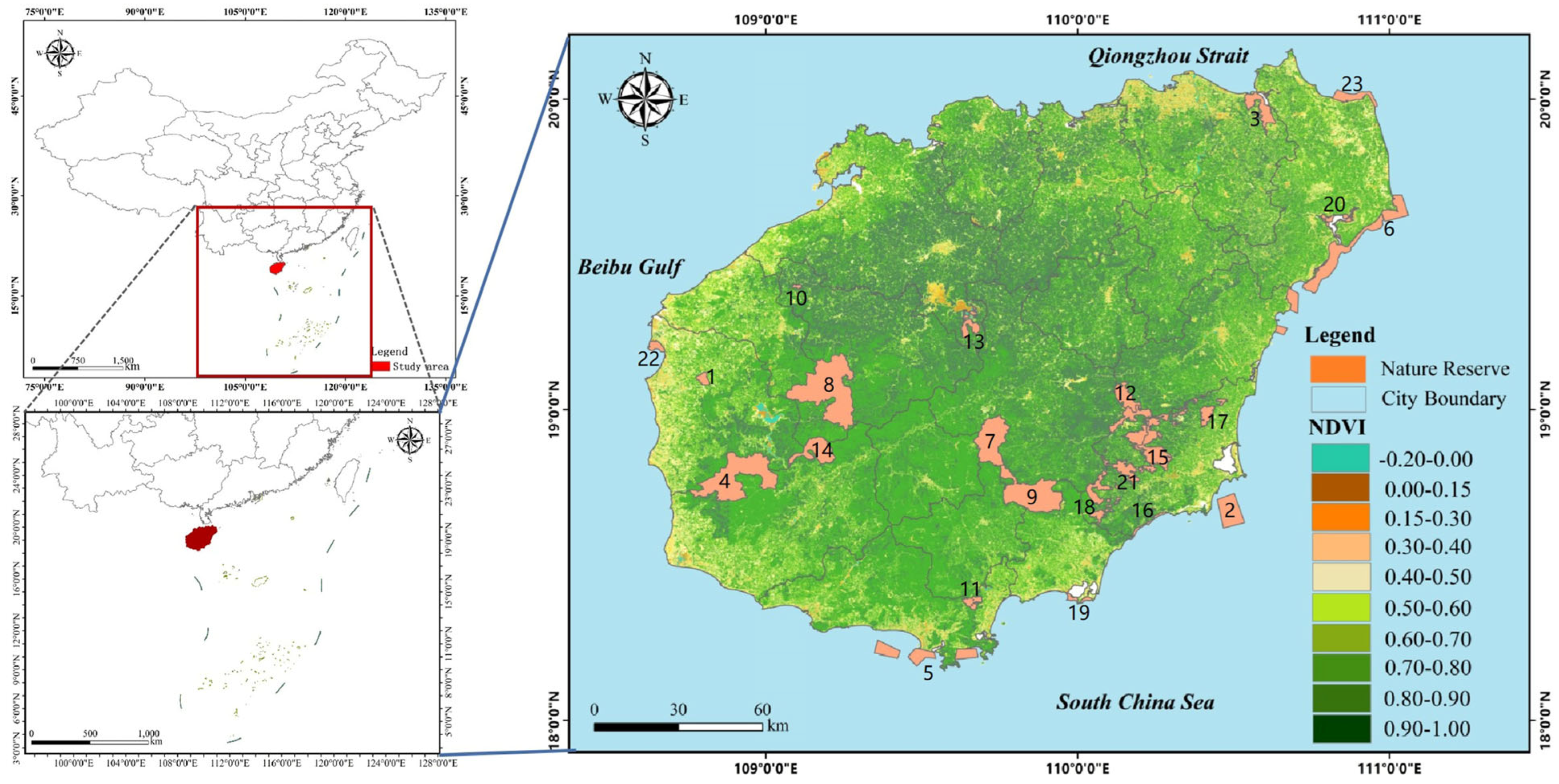
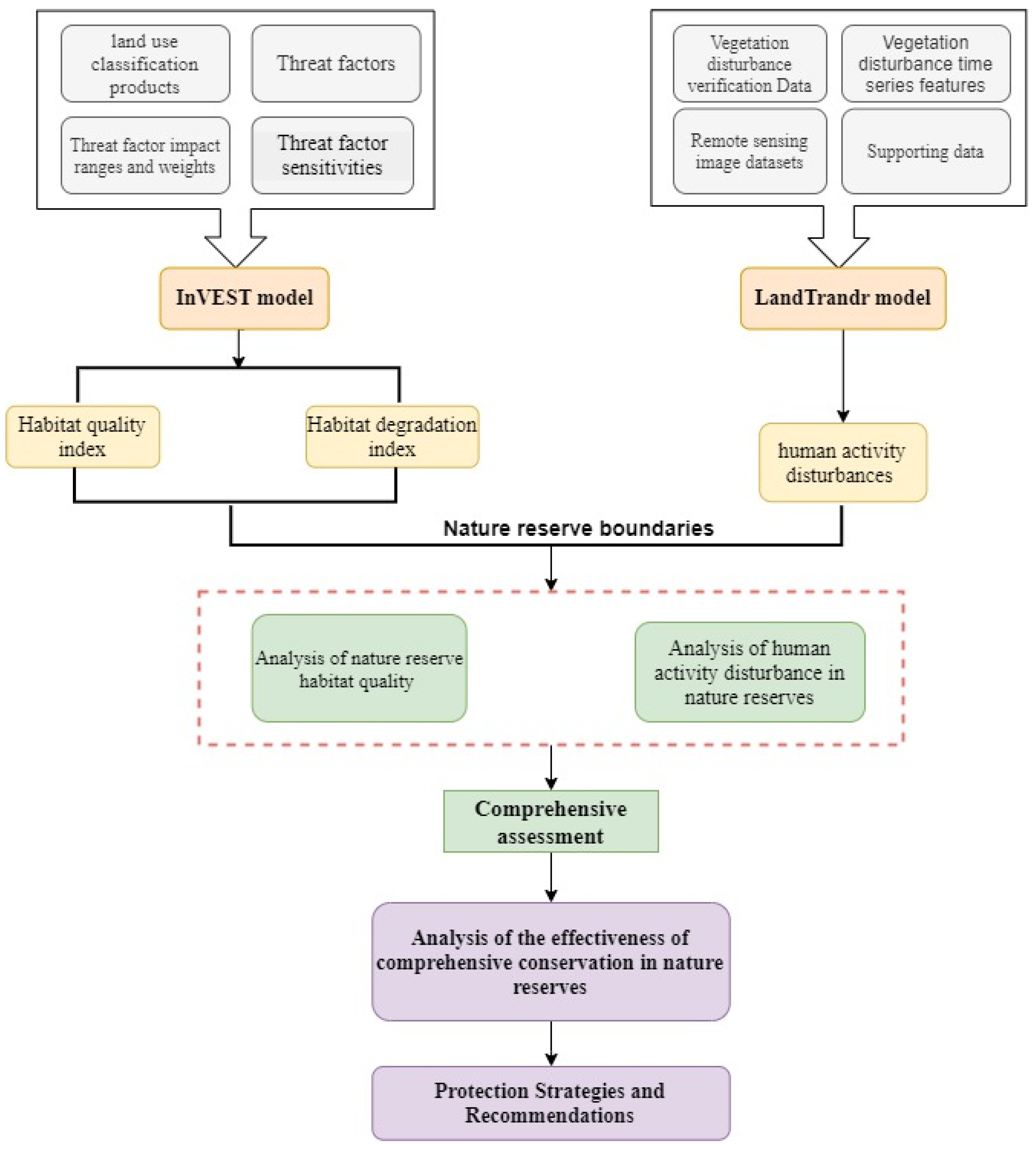



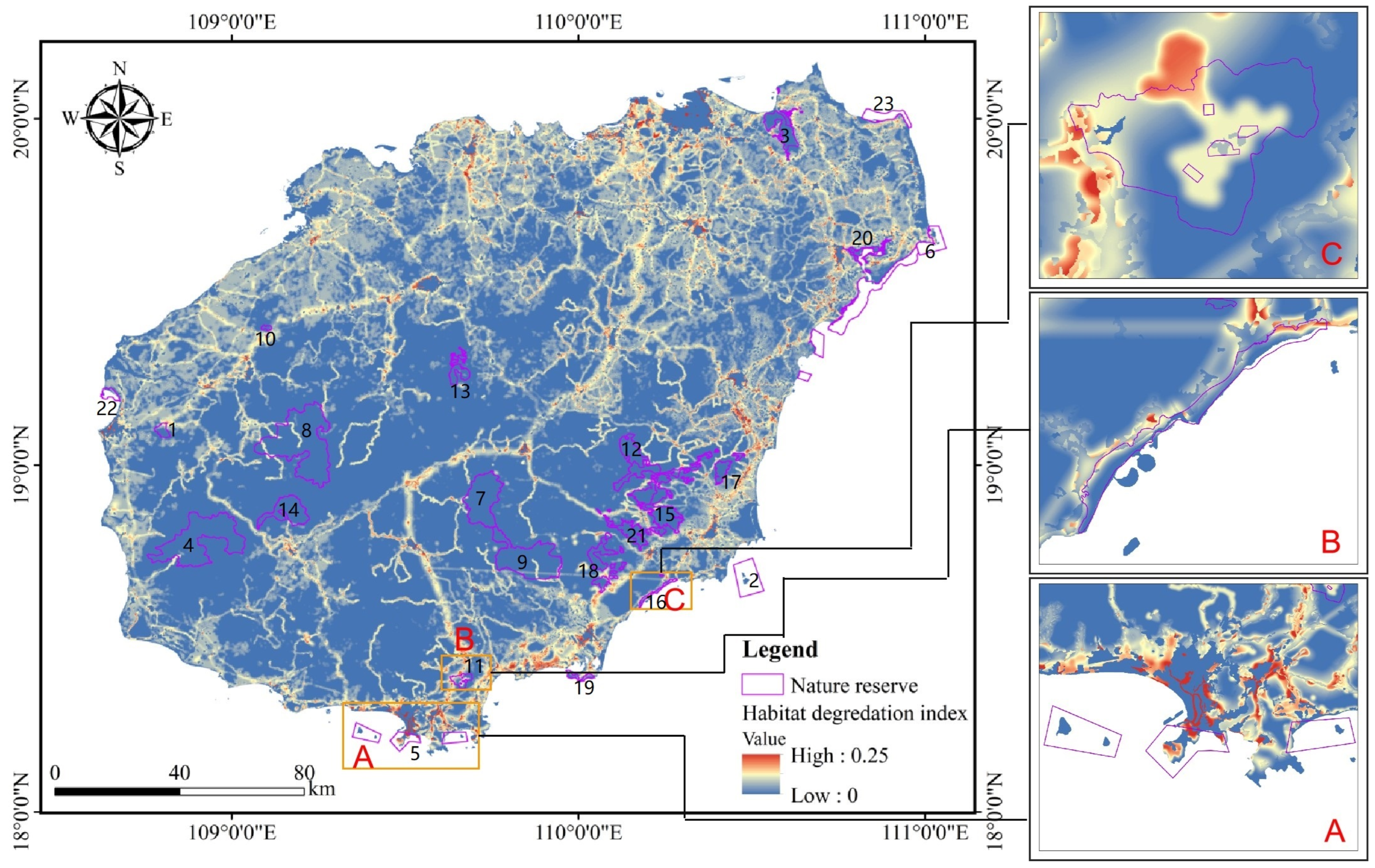
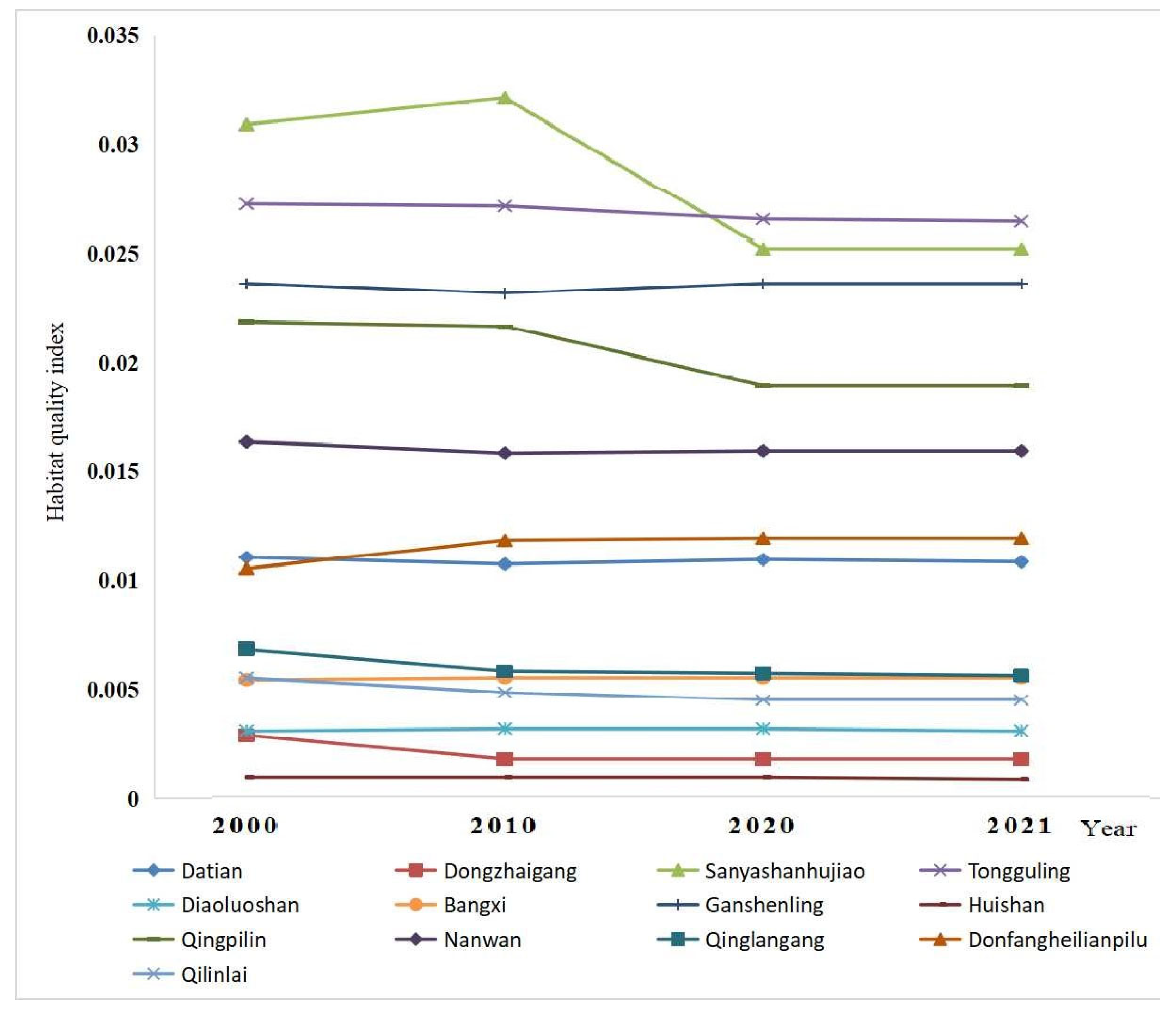
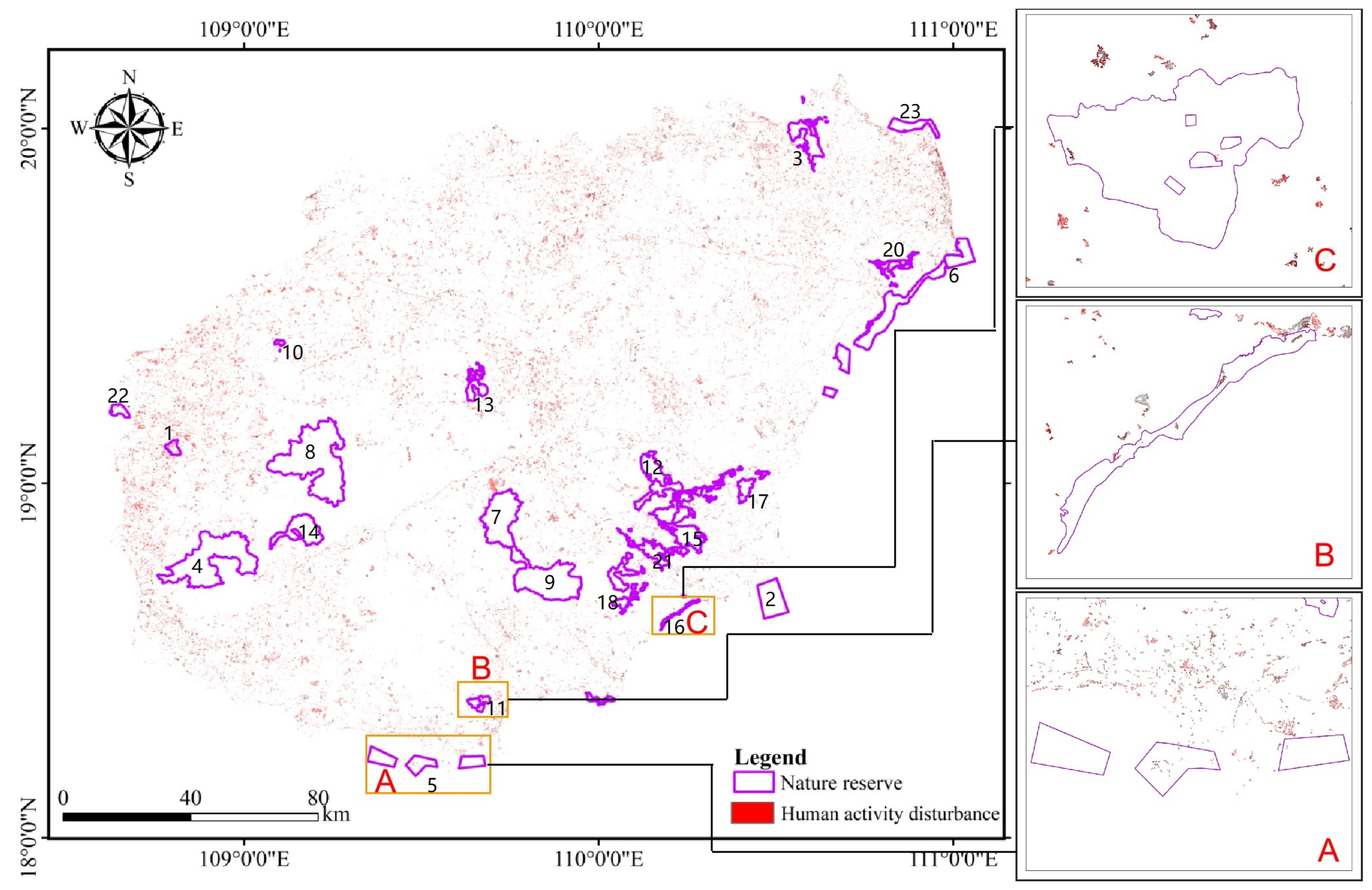
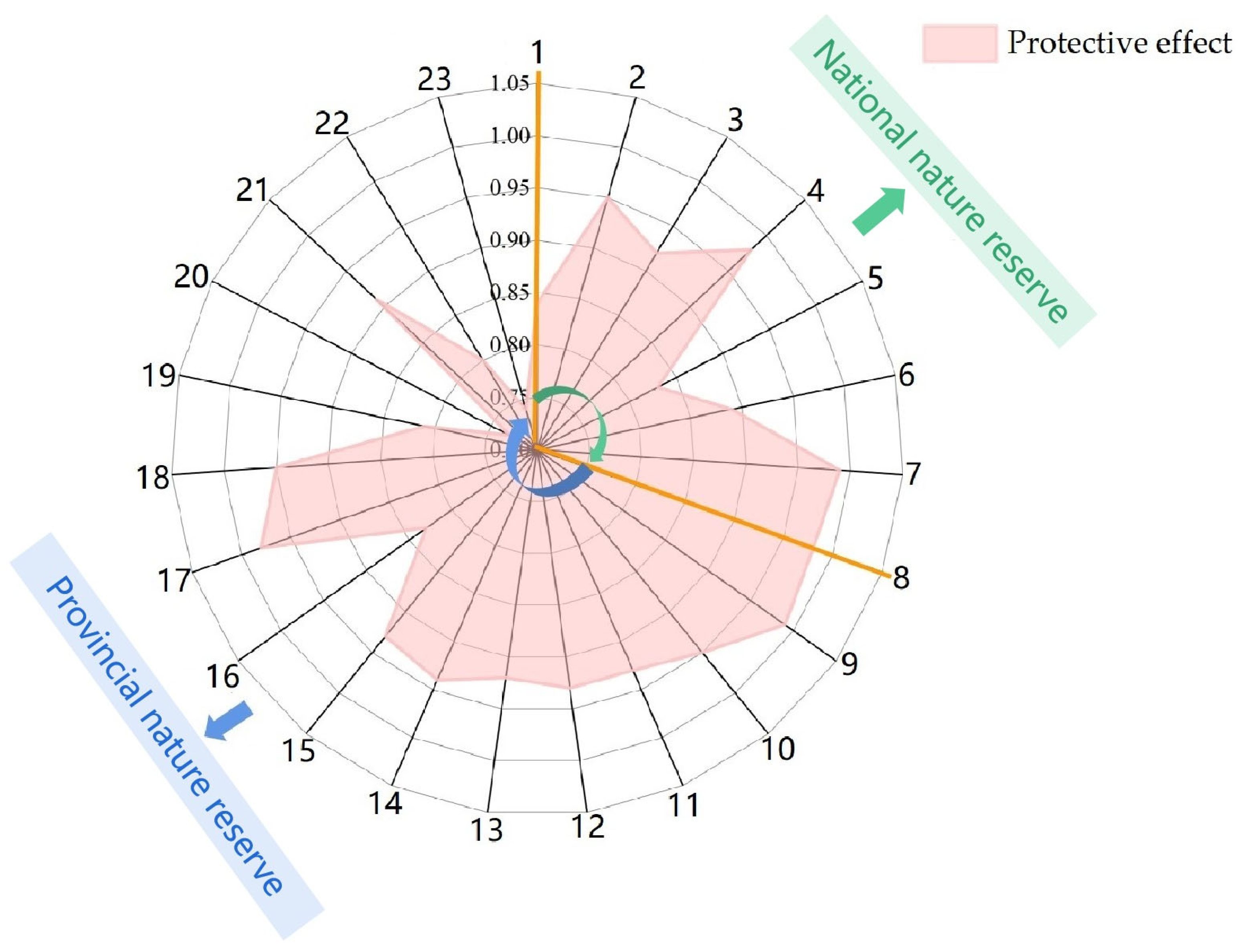
| No. | Level | Name | Type |
|---|---|---|---|
| 1 | National | Datian | Wildlife |
| 2 | Dazhoudao | Wildlife | |
| 3 | Dongzhaigang | Forest ecology | |
| 4 | Jianfengling | Forest ecology | |
| 5 | Sanyashanhujiao | Ocean coast | |
| 6 | Tongguling | Ocean coast | |
| 7 | Wuzhishan | Forest ecology | |
| 8 | Bawangling | Wildlife | |
| 9 | Diaoluoshan | Forest ecology | |
| 10 | Provincial | Bangxi | Wildlife |
| 11 | Ganshenling | Wild plants | |
| 12 | Huishan | Forest ecology | |
| 13 | Fanjia | Forest ecology | |
| 14 | Jiaxi | Forest ecology | |
| 15 | Jianling | Forest ecology | |
| 16 | Qingpilin | Forest ecology | |
| 17 | Liulianling | Forest ecology | |
| 18 | Nanlin | Forest ecology | |
| 19 | Nanwan | Wildlife | |
| 20 | Qinglangang | Ocean coast | |
| 21 | Shangxi | Forest ecology | |
| 22 | Dongfangheilianpilu | Wildlife | |
| 23 | Qilinlai | Wild plants |
| Name | 2000 | 2010 | 2020 | 2021 |
|---|---|---|---|---|
| Datian | III | II | III | III |
| Dazhoudao | I | I | I | I |
| Dongzhaigang | II | I | I | I |
| Jianfengling | I | I | I | I |
| Sanyashanhujiao | IV | IV | IV | IV |
| Tongguling | III | IV | II | II |
| Wuzhishan | I | I | I | I |
| Bawangling | I | I | I | I |
| Diaoluoshan | I | I | I | I |
| Bangxi | IV | IV | IV | IV |
| Ganshenling | II | III | III | III |
| Huishan | II | II | II | II |
| Fanjia | I | I | I | I |
| Jiaxi | I | I | I | I |
| Jianling | I | I | I | I |
| Qingpilin | V | IV | IV | IV |
| Liulianling | I | I | I | I |
| Nanlin | I | I | I | I |
| Nanwan | III | II | II | II |
| Qinglangang | IV | IV | IV | IV |
| Shangxi | I | I | I | I |
| Donfangheilianpilu | IV | IV | IV | IV |
| Qilinlai | IV | V | V | V |
| Name | 2000 | 2010 | 2020 | 2021 |
|---|---|---|---|---|
| Datian |  |  |  |  |
| Dazhoudao |  |  |  |  |
| Dongzhaigang |  |  |  |  |
| Jianfengling |  |  |  |  |
| Sanyashanhujiao |  |  |  |  |
| Tongguling |  |  |  |  |
| Wuzhishan |  |  |  |  |
| Bawangling |  |  |  |  |
| Diaoluoshan |  |  |  |  |
| Bangxi |  |  |  |  |
| Ganshenling |  |  |  |  |
| Huishan |  |  |  |  |
| Fanjia |  |  |  |  |
| Jiaxi |  |  |  |  |
| Jianling |  |  |  |  |
| Qingpilin |  |  |  |  |
| Liulianling |  |  |  |  |
| Nanlin |  |  |  |  |
| Nanwan |  |  |  |  |
| Qinglangang |  |  |  |  |
| Shangxi |  |  |  |  |
| Donfangheilianpilu |  |  |  |  |
| Qilinlai |  |  |  |  |
 excellent,
excellent,  good,
good,  moderate,
moderate,  qualified.
qualified.Disclaimer/Publisher’s Note: The statements, opinions and data contained in all publications are solely those of the individual author(s) and contributor(s) and not of MDPI and/or the editor(s). MDPI and/or the editor(s) disclaim responsibility for any injury to people or property resulting from any ideas, methods, instructions or products referred to in the content. |
© 2023 by the authors. Licensee MDPI, Basel, Switzerland. This article is an open access article distributed under the terms and conditions of the Creative Commons Attribution (CC BY) license (https://creativecommons.org/licenses/by/4.0/).
Share and Cite
Zhang, X.; Yan, M.; Zhang, L.; Chen, B. A Study to Assess the Conservation Effectiveness of Nature Reserves in Hainan, China, from 2000 to 2021. Forests 2023, 14, 1293. https://doi.org/10.3390/f14071293
Zhang X, Yan M, Zhang L, Chen B. A Study to Assess the Conservation Effectiveness of Nature Reserves in Hainan, China, from 2000 to 2021. Forests. 2023; 14(7):1293. https://doi.org/10.3390/f14071293
Chicago/Turabian StyleZhang, Xiaoqian, Min Yan, Li Zhang, and Bowei Chen. 2023. "A Study to Assess the Conservation Effectiveness of Nature Reserves in Hainan, China, from 2000 to 2021" Forests 14, no. 7: 1293. https://doi.org/10.3390/f14071293
APA StyleZhang, X., Yan, M., Zhang, L., & Chen, B. (2023). A Study to Assess the Conservation Effectiveness of Nature Reserves in Hainan, China, from 2000 to 2021. Forests, 14(7), 1293. https://doi.org/10.3390/f14071293








